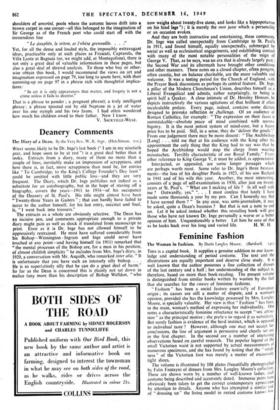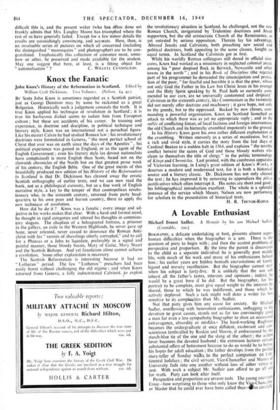Feminine Fashion
The Woman in Fashion. By Doris Langley Moore. (Batsford. 255.) THIS is a capital book. It supplies a genuine addition to our know- ledge and understanding of period costume. The text and the Illustrations are equally important and deserve close study. It is well known that the author possesses a fine collection of dresses of the last century and a half ; her understanding of the subject is. therefore, based on more than book-reading. The present volume is distinguished from similar books written by women by the fact that she searches for the causes of feminine fashions.
" Fashion " has been a social feature essen'ially of European origin its causes are still a matter of dispute, and a woman's opinion, provided she has the knowledge possessed by Mrs. Langley Moore, is specially valuable. Her view is that " Fashion " has been. in the main, woman's method of expressing her individuality. One notes a characteristically feminine reluctance to accept " sex attrac- tion " as the principal motive ; she prefers to regard it as subsidiary. But surely fashion is evidence of the herd instinct, which is opposed to individual taste ? However, although one may not accept her conclusions, the line of argument is persuasive and clearly set out in the first chapter. In the second are a number of interesting observations based on careful research. The popular legend of the small Victorian waist is not supported by actual measurements of numerous specimens, and she has found by testing that the " small ness " of the Victorian foot was merely a matter of excessive') tight shoes. The volume is illustrated by 108 plates (beautifully photographed by Felix Fonteyn) of dresses from Mrs. Langley Moore's collection. These are shown worn by a number of well-known ladies. each costume being described and accurately dated. Immense pains haw obviously been taken to get the correct contemporary apnearano by attention to details. Anyone who has attempted a similar task of " dressing up'' the living model in period costume know' "
difficult this is, and the present writer (who has often done so) frankly admits that Mrs. Langley Moore has triumphed where the rest of us have generally failed. Except for a few minor details the results are astonishingly convincing, and accurate. Here, then, is an invaluable series of pictures on which all concerned (including the distinguished " mannequins " and photographer) are to be con- gratulated. Emphatically this collection of costumes must, some- how or other, be preserved and made available for the student. May one suggest that here, at least, is a fitting object for " nationalisation " ? C. WU LETT CUNNINGTON.



































 Previous page
Previous page